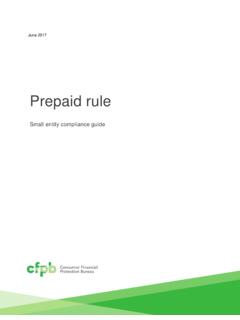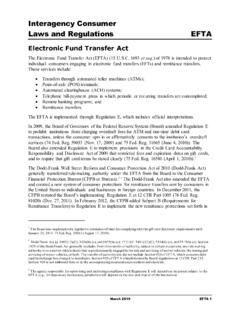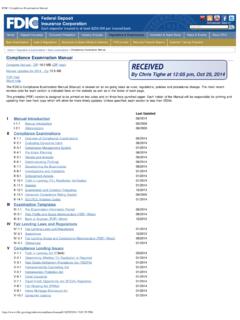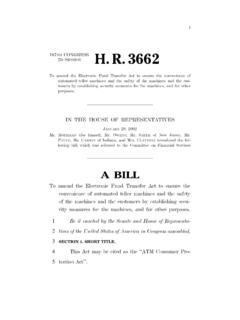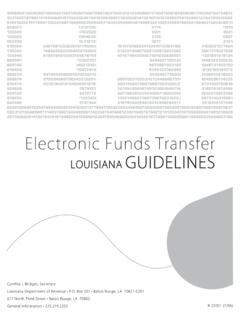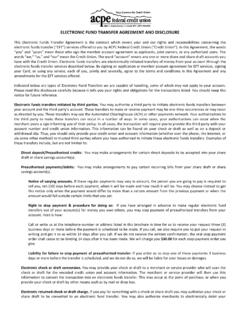Transcription of ELECTRONIC FUND TRANSFER ACT - CCH
1 CCH INCORPORATED Managing Compliance Risk ELECTRONIC fund TRANSFER ACT CCH INCORPORATED Managing Compliance Risk CCH INCORPORATED Managing Compliance Risk ELECTRONIC fund TRANSFER Act Table of Contents I. FOCUSING ON THE BASICS Background p. 3 General Requirements High Points p. 4 Definitions and Acronyms p. 17 II. COMPLIANCE RISK FOCUS RESOURCES p. 21 Sample Policy Statement p. 23 Sample Requirements/Time Frame Grid p. 33 Frequently Cited Violations p. 41 Duty to Investigate Errors p. 45 Liability for Unauthorized Transfers p. 49 III. SNAPSHOT OVERVIEW OF COMPLIANCE RISK p. 53 Assessing the Risk p. 55 Reporting the Findings p. 68 IV. IN-DEPTH REVIEW/SELF-ASSESSMENT CHECKLIST p.
2 69 Regulation E Checklist p. 71 V. REGULATION E (12 CFR 205) p. 93 CCH INCORPORATED Managing Compliance Risk CCH INCORPORATED Managing Compliance Risk ELECTRONIC fund TRANSFER Act 1 I. FOCUSING ON THE BASICS CCH INCORPORATED Managing Compliance Risk ELECTRONIC fund TRANSFER Act 2 CCH INCORPORATED Managing Compliance Risk ELECTRONIC fund TRANSFER Act 3 BACKGROUND The ELECTRONIC fund TRANSFER Act (EFTA) (15 USC 1693 et seq.) was enacted on November 10, 1978, and is implemented by the Federal Reserve Board s Regulation E (12 CFR 205). The EFTA provides a basic framework establishing the rights, liabilities, and responsibilities of customers who use ELECTRONIC fund TRANSFER (EFT) services and financial institutions that offer these services Examples of EFTs are: Automated teller machine (ATM) transfers; Telephone bill-payment transfers; Point-of-sale transfers; Preauthorized transfers from or to a customer's account ( , direct deposits or withdrawals of funds); and Transfers resulting from debit card transactions, whether or not initiated through an ELECTRONIC terminal.
3 As defined in the EFTA and Section (b) of Reg. E, the term ELECTRONIC fund TRANSFER , refers to a transaction initiated through an ELECTRONIC terminal, telephone, computer, or magnetic tape that orders, instructs, or authorizes a financial institution to either credit or debit a customer's asset account. The term ELECTRONIC terminal includes point-of-sale terminals, ATMs, and cash dispensing machines. The customer generally is issued a card or a code (known as an access device), or both, to initiate transfers. CCH INCORPORATED Managing Compliance Risk ELECTRONIC fund TRANSFER Act 4 GENERAL REQUIREMENTS HIGH POINTS EXEMPTIONS (12 CFR (c)) The following types of ELECTRONIC fund transfers are not covered by the EFTA: Transfers originated by check; Check guarantee or authorization services that do not directly result in a debit or credit to a customer's account; Any TRANSFER of funds for a customer within a system that is used primarily to TRANSFER funds between financial institutions or businesses.
4 An example is a wire TRANSFER of funds for a customer through the Fedwire; Any TRANSFER of funds that has as its primary purpose the purchase or sale of securities or commodities regulated by the Securities and Exchange Commission (SEC) or the Commodity Futures Trading Commission (CFTC), purchased or sold through a broker-dealer regulated by the SEC or through a futures commission merchant regulated by the CFTC, or held in book-entry form by a Federal Reserve Bank or federal agency. Intra-institutional automatic transfers under an agreement between a customer and a financial institution: Between the customer s account and the institution itself (except that Section (e) on compulsory use and Sections 915 and 916 of the EFTA on civil and criminal liability are applicable); Between two accounts of the customer within the institution; or From the customer's account to a family member's account within the institution.
5 Transfers initiated by telephone between a customer and a financial institution that are not executed under a written plan contemplating periodic or recurring transfers. Preauthorized transfers to or from an account held at a financial institution with assets of $100 million or less on the preceding December 31 (except that Section (e) and Sections 915 and 916 of the EFTA are applicable). SPECIAL REQUIREMENTS (12 CFR ) Section (a) requires that disclosures be clear and readily understandable, in writing, and in a form the customer may keep. Section (b) permits, at the institution's option, the disclosure of additional information and allows disclosures required by other laws, , Truth in Lending Act disclosures, to be combined with Reg. E disclosures.
6 Section (d)(1) permits the institution holding an account to combine required disclosures into a single statement if a customer holds two or more accounts at an institution. A single periodic statement or error resolution notice is sufficient for multiple accounts. In order to CCH INCORPORATED Managing Compliance Risk ELECTRONIC fund TRANSFER Act 5 comply with Section (d)(2), an institution need provide only one set of disclosures for a joint account. Section (e) permits two or more institutions that jointly provide EFT services to contract among themselves to fulfill the requirements that the regulation imposes on any or all of them. When making disclosures under Section (Initial Disclosures) and Section (Change in Terms; Error Resolution Notice), an institution in a shared system need only make those required disclosures that are within its knowledge and the purview of its relationship with the customer for whom it holds an account.
7 ISSUANCE OF ACCESS DEVICES (12 CFR ) Section governs the issuance of access devices. For access devices that also constitute credit cards, the issuance rules of Reg. E apply if the only credit feature is a preexisting credit line attached to the asset account to cover overdrafts (or to maintain a specified minimum balance). Regulation Z rules apply if there is another type of credit feature, , one permitting direct extensions of credit that do not involve the asset account. In general, an institution may issue an access device to a customer only if the access device is: Requested (in writing or orally) or applied for; or Renewal of, or in substitution for, an accepted access device (as defined in Section (a)). An institution may issue an access device to each accountholder of a joint account for which the requesting holder specifically requests an access device.
8 An institution may issue an unsolicited access device only if the access device is: Not validated, , it cannot be used to initiate an EFT; Accompanied by a statement explaining that the device is not validated and how it may be disposed of if the customer does not wish to validate it; Accompanied by a complete disclosure, in accordance with Section , of the customer's rights and liabilities that will apply if the device is validated; and Validated only after an oral or written request from the customer and verification of the customer's identity by some reasonable means. These conditions are intended to reduce the potential for unauthorized use if the access device is lost or stolen en route to the customer and to ensure that the customer is informed of account terms and conditions before deciding whether to accept the responsibilities of having an access device.
9 CCH INCORPORATED Managing Compliance Risk ELECTRONIC fund TRANSFER Act 6 LIABILITY OF CUSTOMERS FOR UNAUTHORIZED TRANSFERS (12 CFR ) A customer may be held liable for unauthorized EFTs (as defined in Section (m)) only if: The institution has provided the following written disclosures to the customer: A summary of the customer's liability for unauthorized EFTs; The telephone number and address for reporting that an unauthorized EFT has been or may be made; and The institution's business days; The access device is accepted (as defined in Section (a)); and The institution has provided a means to identify the customer to whom the access device was issued. Loss or Theft of Access Device If customer notifies the bank: Within two business days after learning of loss or theft: Liability is the lesser of $50; or Total amount of unauthorized transfers.
10 More than two business days after learning of loss or theft: Liability is the lesser of $500; or The sum of: $50 or the total amount of unauthorized transfers occurring in the first two business days, whichever is less; and The amount of unauthorized transfers occurring after two business days and before notice to the institution. More than 60 calendar days after transmittal of statement showing first unauthorized TRANSFER made with access device: For transfers occurring within the 60-day period, the lesser of $500, OR the sum of: The lesser of $50 or the amount of unauthorized transfers in first two business days; and The amount of unauthorized transfers occurring after two business days. For transfers occurring after the 60-day period, unlimited liability (until the institution is notified).
